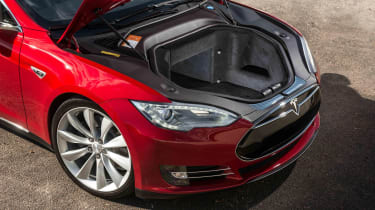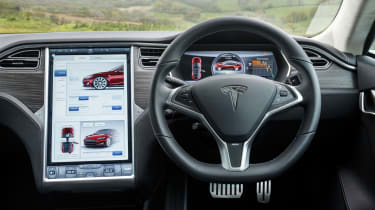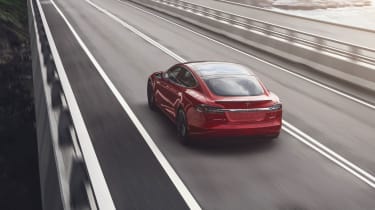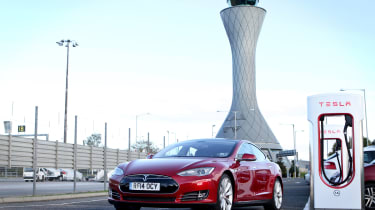Used Tesla Model S buying guide
If you’re thinking of buying a secondhand Tesla Model S, read our handy guide first

The Tesla Model S is still on sale as a new car, but it’s nearly a decade old – and that means this ahead-of-its-time electric car is readily available as a used car. The Model S took mainstream car makers by surprise, as the likes of Mercedes and Audi had nothing that could rival it when the Model S came out.
The Model S was a technological achievement in terms of electric range and performance, but clever features such as the seven-seater layout in some models and the hatchback boot meant that it was a useful, practical family car as well.
The most powerful version of the Model S went from 0-60mph in just 2.5 seconds and could travel 381 miles on a single charge, which is still highly competitive with the most advanced EVs available in 2021. Read on to find out everything you need to know about the Model S before you consider buying a used example.
History
June 2008: The Tesla Model S was announced for the first time.
March 2009: A prototype is shown to the public for the first time.
June 2012: Tesla begins production of its first mainstream car, the Model S.
June 2014: This is the date to look out for, as it was when the first right-hand drive cars appeared in the UK. At launch, the range featured the P60, the P85 and P85 Performance Plus models. The latter two had an 85kWh battery pack, but the Performance Plus had more torque than the P85.
February 2015: The Model S P85D arrives, with twin electric motors to give four-wheel drive.
April 2015: The Model S P60 is replaced by the P70D, which had four-wheel drive.
July 2015: A Model S P90D is introduced, with a 90kWh battery pack, along with a rear-wheel-drive P70 with a 70kWh battery pack.
May 2016: The Model S P70 and P70D are replaced by the P75 and P75D and there's a new entry-level model, the P60, which also comes in four-wheel drive P60D form.
August 2016: There's a new range-topper, the Model S P100D, with a 100kWh battery pack and standard air suspension.
October 2016: A new, more advanced Autopilot function is announced. Called Enhanced Autopilot, it features far more cameras and sensors, plus new software to control everything. There's also an even more high-tech system available at extra cost, called Advanced Autopilot.

Which one should you buy?
The numbers in the model names are a decent place to start, as they indicate the size of the battery pack – the 60 models have a 60kWh pack, the 70 models have 70kWh and so on. The bigger the battery, the longer the range – in most cases. The Performance models tend to sacrifice some range for extra power and acceleration. The larger-battery models are likely to hold their value for longer, as the range is longer and the larger size will mean they take longer to deteriorate – not that this is currently an issue.
The Tesla Model S was well-equipped in every form, though optional extras were popular with buyers for this luxury car. Standard kit included 17-inch touchscreen infotainment system with Bluetooth and DAB, 19-inch alloy wheels, xenon headlights and a reversing camera. Extras to look out for in a used model include air suspension, upgraded seats and extra driver assistance systems within the Autopilot package.

Alternatives
There are a few mainstream rivals for the Tesla Model S as a new car, including the Porsche Taycan and Audi e-tron GT, but these are so new that there won’t be many for sale secondhand yet, and those that are will be much more expensive than an older Model S.
Options to consider include some plug-in hybrids such as the Mercedes S 500 e, which uses a twin-turbo 3.0-litre V6 petrol engine backed up by a 114bhp electric motor. It's everything you'd expect of a Mercedes S-Class in terms of luxury, refinement and high-tech safety kit, but there's no seven-seat option and the luggage capacity can't match the Tesla's.
There’s also the option of an E-Class plug-in hybrid instead – specifically an E 350 e, though the de model’s diesel engine could work well if you do a lot of long trips. Neither are as powerful as a Model S, but they offer relief from range anxiety. Another option could be the BMW 530e, another plug-in hybrid that features a 184bhp 2.0-litre four-cylinder petrol engine supported by a 95bhp electric motor. It’s better to drive than the Model S, better-built, has just as much tech and is comfortable and practical.

Verdict
For an established luxury carmaker to have come up with the Model S would have been impressive, but the fact that Tesla didn't build its first car until 2008 makes it even more remarkable. Having caught the big players napping, the Model S cornered the luxury electric segment for several years and even now this is a very desirable car.
In some corners of the media, the Model S has been pilloried for its poor reliability, but the cars worst affected by glitches seem to be the earliest examples, and Tesla has worked swiftly to make constant improvements, while it has a habit of looking after its customers in the event of repairs being needed. Either way, the Model S is a very complicated car and you need to check any potential purchase very carefully – but land a cherished one and you'll love it.
Checklist
• When there's a letter D after a Model S' name, it denotes a second (Dual) motor, to give four-wheel drive. If there isn't a D in the designation, the car is rear-wheel drive instead.
• Even relatively minor damage can cost a small fortune and take ages to fix, partly because of the Tesla's design and partly because there are so few accredited repair centres. Even minor pothole damage can lead to a Model S being off the road for weeks, waiting for parts to arrive.
• The doorhandles are meant to glide out, ready for you to open the door – but sometimes the mechanism fails.
• If there's any juddering through the pedal as you brake, it's because the brake discs have worn – something that's a disappointingly common problem.
• The windscreen wipers can behave erratically and so can the exterior lights. Other potential electrical glitches involve the infotainment system and climate control, so check absolutely everything – twice.
Recalls
November 2015: Faulty seatbelt pre-tensioners were fitted to some of the Model S' built between February 2014 and November 2015.
April 2017: Because of a manufacturing fault, the parking brake could fail to release on some Model S' made between February and October 2016.
January 2018: Just three Model S' were recalled because of faulty airbags; Tesla didn't disclose the build dates of the cars affected.
March 2018: Between May 2012 and April 2016, the Model S' steering featured aluminium bolts to retain the power assistance motor. These bolts could fail leading to a loss of power assistance for the steering; affected cars were fitted with stainless-steel bolts.
January 2019: In the event of a collision the front passenger airbag could rupture on cars built between March 2014 and December 2016.

Running costs
• Insurance group: 40
• Typical range: 208 miles (P65) to 340 miles (P100)
• CO2 emissions: 0g/km
The Tesla's service intervals are set at every 12 months or 12,500 miles, with a slightly different service requirement for the first four services, then the schedule starts again at the beginning. At the time of writing (October 2019) the first service was pegged at £375 and involves replacing the cabin air filter, the key fob battery and the wiper blades, as well as a multi-point inspection.
The second service is priced at £650 and includes everything from the first service plus fresh brake fluid and a service for the air conditioning system. The third service is the same as the first, then the fourth service is the same as the second, but the battery coolant has to be replaced, so the price is pegged at £800.
It's worth checking if any Model S that you're thinking of buying comes with the balance of a pre-paid service plan. At the time of writing it was possible to pay up front for three years' servicing (£1,225), four years (£1,925) or eight years (£3,675).
Most Popular

EV Deal of the Day: Dacia Spring is amazingly good value at £116 per month

